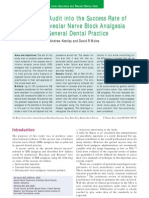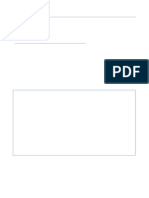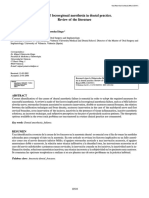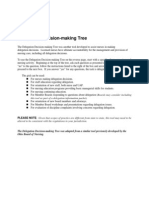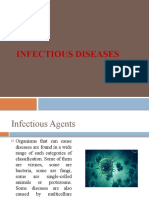JMBS2010 (1 8)
JMBS2010 (1 8)
Uploaded by
DoVa XuCopyright:
Available Formats
JMBS2010 (1 8)
JMBS2010 (1 8)
Uploaded by
DoVa XuOriginal Title
Copyright
Available Formats
Share this document
Did you find this document useful?
Is this content inappropriate?
Copyright:
Available Formats
JMBS2010 (1 8)
JMBS2010 (1 8)
Uploaded by
DoVa XuCopyright:
Available Formats
Journal of Medicine and Biomedical Sciences, ISSN: 2078-0273, May, 2010
INCIDENCE OF COMPLICATIONS OF INFERIOR ALVEOLAR NERVE BLOCK INJECTION
BDS, OMFS, DSC. Nasser Nooh 2 BDS, MSC, PhD, Walid A. Abdullah
Associate Professor; Head Division and Consultant of oral and maxillofacial surgery, Faculty of dentistry, King Saud University (KINGDOM OF SAUDI ARABIA) 2 Assistant Professor; Consultant of Oral and Maxillofacial Surgery, Faculty of dentistry, King Saud University (Kingdom of Saudi Arabia), and lecturer of Oral and Maxillofacial Surgery, Faculty of dentistry, Mansoura University (EGYPT) *Corresponding author: nnooh6@gmail.com
1
1*
ABSTRACT Objective: The aim of this study was to assess the immediate complications after injection of inferior alveolar nerve block (IANB) using a modified indirect technique. Patients and Methods: A total of 5000 IANB injections was performed by an oral and maxillofacial surgeon for a total of 3454 adults. Patients with hyperthyroidism were excluded from the study. The following data were collected: name, age, sex, and side of the IANB. Furthermore, the presence of any complication was noted as well as its type, persistence, and severity. All data were analyzed using SPSS (SPSS Inc., Chicago, IL), and descriptive statistics were generated. Results: Failures of IANB and the need for second injections were seen in 48 patients (1%). Positive aspirations were noted in 84 patients (1.7%). Blanching of the cheek was found in four patients (0.08%), which persisted for about 5 minutes. Two patients (0.04%) had electrical pain radiating to the tongue. In addition, facial paralysis was seen in one patient (0.02%), persisting about 4 hours, and there were two cases of blurred vision (0.04%) Conclusion: Based on the results and within the limitations of the study, the following can be concluded: This technique shows lower failure rate, lower positive aspiration rate, and lower incidence of facial paralysis than the standard technique described by Malamed. In addition, aspiration is important before the deposition of the anesthetic solution in IANB. Key words: immediate complications, inferior alveolar nerve block, oral and maxillofacial surgery
INTRODUCTION Probably one of the most common procedures in dentistry is the administration of local anesthetic. The inferior alveolar nerve block (IANB) is the most frequently used mandibular injection technique for achieving local anesthesia 2 for restorative and surgical procedures. In 1884, Halsted and Hall described the first inferior alveolar regional nerve block by injecting an anesthetic 3 solution ( cocaine) into the area of the mandibular foramen. Then, Fischer , described the classic technique which, 4 was modified later by many authors. Nowadays, most of the dentists all-around the world are using a technique 3,5 although, similar to the one described by Jorgensen and Hayden in 1967, which targeting the mandibular nerve. there are some complications associated with this standard IANB technique, it is still considered by many authors as 3,5 the technique with the least complications, safest administration, and least discomfort to the patients. An anesthetic complication can be defined as any deviation from the normally expected pattern during or after 6 the injection of local anesthesia. Complications of local anesthesia can be classified as local or systemic. These complications may include local and/or systemic immediate post-injection, as failure, needle breakage, penetration of a blood vessel, hematoma, nerve damage, facial nerve paresis, blanching, and reactions (eg, overdose, allergy, 15 idiosyncrasy). Different techniques are used in IANB. Therefore, the aim of this study was to assess the incidence, types, and severity of the complication(s) of IANB injection given using a modified, indirect injection technique. This study is 1 similar to research by Joseph et al ; this current study focused only on the inferior alveolar nerve injection with a larger number of injections for more reliable and accurate results. PATIENTS AND METHODS Patients This study period was from March 2001 to November 2008 with 3,454 adults Saudi patients who received a total of 5000 IANB injections. Only patients with hyperthyroidism were excluded. The study involved 1841 females and 1613 males between 17 to 56 years old with a mean age of 36. The reasons for IANB injections were extractions of wisdom teeth (74.7%) and extractions of other mandibular posterior teeth (25.3%) (Table 1). Only patients who are treated at Oral and Maxillofacial surgery clinic are included in this study. All patients are Saudi referred for extraction of the lower Molar teeth.
1
52
Journal of Medicine and Biomedical Sciences, ISSN: 2078-0273, May, 2010
IANB Technique All the IANB injections were done by one experienced oral and maxillofacial surgeon using the same syringe design and long 27-gauge needles (Fig.1). The needle was inserted from the opposite premolar to touch the anteromedial aspect of the ramus 1.5 cm above the occlusion level (Fig.2), then the needle was redirected by moving the syringe to the same side of injection above the occlusion level (Fig. 3). Then the needle was advanced in contact with the bone 75% of the needle length should be inserted( about 30 to 34 mm ) (Figs. 4,5).
Fig. 1. Syringe design and long 27-gauge needle used in the study
Fig. 2. The needle was inserted from the opposite premolar to touch the antero-medial aspect of the ramus 1.5 cm above the occlusion level
Fig. 3. The needle was redirected by moving the syringe to the same side of injection above the occlusion level Fig. 4. The needle was advanced in contact with the bone 75% of the needle length (about 30 to 34 mm)
Fig. 5. Showing the length of the needle that should be inserted before deposition of the anesthetic solution.
53
Journal of Medicine and Biomedical Sciences, ISSN: 2078-0273, May, 2010
Table 1. Demographic characteristics of participating subjects number Age Bilateral IANB Unilateral IANB Cause (wisdom teeth extractions) 1718 Cause (other lower posterior teeth extractions) 477
Male
1613
18:56 y Mean (37y) 17:52y Mean (35y) Mean (36y)
Female
1841
total
3454
582 1031 (1164 injections) 964 877 (1928 injections) 1546 1908 (3092 injections) 5000 IANB injections
2017
788
3735
1265
74.7 %
25.3%
If there is no bone contact, the needle is withdrawn and redirected until having bone contact, we never inject unless we have a bone contact. Aspiration was performed, and then 1.8 cc of local anesthesia solution (2% lidocaine with 1:100,000 epinephrine 1.8 cc cartridge) was deposited for the anesthesia of inferior alveolar and lingual nerves. Then 0.3 cc of 2% lidocaine with 1:100,000 epinephrine solutions was injected in the buccal sulcus opposing to the affected tooth as an infiltration to the long buccal nerve. We used only one 1.8 cc cartridge of (2% lidocaine with 1:100,000 epinephrine) in all patients as IANB at the start of the procedure, then if patients showed improper anesthetic effect for extraction we injected with a second cartridge and considered as a failure in the first injection trail. Data Collection and Statistical Analysis In all patients, the following data were collected: name, age, sex, and side of the IANB. The presence of any complications was noted, including type, persistence, and severity. All data were analyzed using SPSS, and descriptive statistics were generated. RESULTS A total of 5000 IANB injections were administered during the study period. Failures and the need for a second injection occurred in 48 patients (1%). Positive aspirations were noted in 84 patients (1.7%). Blanching of the cheek was seen in four patients (0.08%), which persisted about 5 minutes. Two cases of blurred vision (0.04%) were recorded in two female patients, both on the right side (IANB), and both patients showed complete improvement after about 7 minutes. Two patients (0.04%) had electrical pain radiating to the tongue. One person had facial paralysis (0.02%), which persisted about 4 hours. Needle breakage, overdose, allergy or idiosyncrasy, and persistent nerve damage were not found in any patient. Table 2 summarizes the incidence of complications and their duration in all patients. Table 2. Number (%) of complications encountered following IANB Complication Failure Positive aspiration Blanching Blurred vision Facial paralysis Electrical pain DISCUSSION According to failure rate, this study showed IANB failure was present in 1% of IANB injections. These results 2,3,7 7 were significantly different from previous studies. Wong and Jacobsen reported a failure rate of 5% to 15%. In 5 addition, Malamed identified the inferior alveolar nerve block as the injection with the highest clinical failure rate (15% to 20%) when properly administered. Furthermore, Malamed attributed failure to a high degree of variation in the morphology of the mandibular ramus and the location of the mandibular foramen; however, improper technique is the 3,5,8 Because of the specialty in which IANB is given, the authors results showed lower most common reason for failure. 9 10 failure rate (1%) when compared with the results of Cohen et al and Nusstein et al who reported that the failure rate of IANB to be between 38% and 75% of the time in their endodontic clinical trails. Incidence number 48 84 4 2 1 2 percentage 1% 1.7 % 0.08 % 0.04 % 0.02% 0.04 % duration
4 minutes 7 minutes 4 hours
54
Journal of Medicine and Biomedical Sciences, ISSN: 2078-0273, May, 2010
Most of the time, success rates are reportedly higher when a single individuals first demonstration of anesthesia success is published. A random prospective trial would be required using a standard technique for comparison. The authors of this current study saw a reasonably low positive aspiration rate (1.7%) compared with the results 11,12 11 12 Taghavi Zenouz et al reported an incidence of 15.3%, while Blanton and Roda stated that of previous studies. they had a positive aspiration rate of 10% to 15%. This relatively high percentage was decreased in the Gow-Gates 13 technique to 1.6% to 1.9%. 13 14 Garcia et al and Brodsky and Dower indicated the IANB method is superior to the Gow-Gates technique in percentages of intravascular puncture; this is related to the large quantity of vascular elements present in the pterygomandibular space. For this reason, it has been stated that the IANB technique is risky for patients who have 15 some kind of blood dyscrasias. From this point, the authors consider their technique to be more superior to the standard regular IANB injection method, as it has a significantly different positive aspiration rate and a comparable result with Gow-Gates. Although there is a significant difference between the authors study results regarding positive aspiration (1.7%) 16 and those of Frangiskos et al (20%), the authors of this paper agree with them that intravascular injection of local anaesthetic during inferior alveolar nerve block is more or less a common complication. So aspiration is mandatory 17 before the solution deposition during IANB. However, the authors disagree with Martis et al, who stated that aspiration is not necessary because complications from intravascular injection of local anesthesia are uncommon. Because even if the incidence is very low, yet the complication ( if happened) is serious , so we have to do our precautions to avoid this low incidence complication by making aspiration prior to each IANB injection. Visual problems include blurring of vision or blindness, which can be temporary or permanent. Motor problems include mydriasis, palpebral ptosis, and diplopia. Horner-like manifestations involving ptosis, enophthalmos and miosis 18-20 21 of the eye also have been reported. Fortunately, most complications in the eye are transient. Rood reported a case in which 1.5 mL of lidocaine with epinephrine (1:80,000) in IANB, immediate loss of vision developed in the ipsilateral eye, along with upper-eyelid ptosis. Yet, within 5 minutes to 45 minutes, all symptoms had disappeared. 20,22 In this study, the incidence of blurred Unfortunately, cases of permanent complications also have been reported. vision was (0.04%), which was improved completely within 7 minutes. This result is in agreement with what was 18 reported by Ngeow et al. 23 The authors agree with Uckan et al that blanching and ischemia are reported as rare local complications of local anesthesia Blanching incidence in the current study was (0.08%) Few articles document patients and clinical photographs. 1 Needle breakage was not seen during the study, and the authors agree with Lustig and Zusman who reported needles now are made of one piece of metal tube with a soft plastic hub. Occurrences of needle breakage are reported anecdotally; better manufacturing techniques and single use may account for this. 24 The incidence of temporary facial palsy in this study (0.02%) was less than Keetley and Moles results, which found a 0.3% rate. The facial nerve is embedded in the substance of the parotid gland, which has a deep lobe extending around the posterior ramus of the mandible and projecting forward on the medial surface of the ramus. If the injection is made too far posteriorly, the anesthetic solution may be injected into the substance of the parotid gland and could involve the facial nerve. If this happens, the patient will complain immediately of an inability to blink the eye, 25 followed by a sense of paralysis on the same side of the face. CONCLUSION The authors technique shows lower failure rate, lower positive aspiration rate, and lower incidence of facial 5 paralysis compared with the standard technique described by Malamed. Aspiration is important before the deposition of the anesthetic solution in IANB. REFERENCES
1. 2. 3. 4. 5. 6. 7. 8.
Lustig JP, Zusman SP. Immediate complications of local anesthetic administered to 1,007 consecutive patients. J Am Dent Assoc. 1999;130(4):496-499. Hannan L, Reader A, Nist R, et al. The use of ultrasound for guiding needle placement for inferior alveolar nerve blocks. Oral Surg Oral Med Oral Pathol Oral Radiol Endod. 1999;87(6):658-665. Johnson TM, Badovinac R, Shaefer J. Teaching alternatives to the standard inferior alveolar nerve block in dental education: outcomes in clinical practice. J Dent Educ. 2007;71(9):1145-1152. Waikakul A, Punwutikorn J. A comparative study of the extra-intraoral landmark technique and the direct technique for inferior alveolar nerve block. J Oral Maxillofac Surg. 1991;49(8):804-808. Malamed SF. Handbook of Local Anesthesia.4th ed. St. Louis, MO: C.V. Mosby Co.; 1997. Bennett RC. Monheims Local Anesthesia and Pain Control in Dental Practice.7th ed. St. Louis, MO: C.V. Mosby Publishing; 1984. Wong MK, Jacobsen PL. Reasons for local anesthesia failures. J Am Dent Assoc. 1992;123(1):6973. Madan GA, Madan SG, Madan AD. Failure of inferior alveolar nerve block: exploring the alternatives. J Am Dent Assoc. 2002;133(7):843-846.
55
Journal of Medicine and Biomedical Sciences, ISSN: 2078-0273, May, 2010
9. 10. 11. Cohen HP, Cha BY, Spngberg LS. Endodontic anesthesia in mandibular molars: a clinical study. J Endod. 1993;19(7):370-373. Nusstein J, Reader A, Nist R, et al. Anesthetic efficacy of the supplemental intraosseous injection of 2% lidocaine with 1:100,000 epinephrine in irreversible pulpitis. J Endod. 1998;24(7):487-491. Zenouz AT, Ebrahimi H, Mahdipour M, et al. The incidence of intravascular needle entrance during inferior alveolar nerve block injection. Journal of Dental Research Dental Clinics Dental Prospects. 2008;2(1):38-41. Blanton PL, Roda RS. The anatomy of local anesthesia. J Calif Dent Assoc. 1995;23(4):55-58. Apolinar GP, Blanca GM, Jos MMJ. Risks and complications of local anaesthesia in dental office: current situation. RCOE. 2003;8(1):41-63. ( article in Spanish). Brodsky CD, Dower JS Jr. Middle ear problems after a Gow-Gates injection. J Am Dent Assoc. 2001;132(10):1420-1424. Piot B, Sigaud-Fiks M, Huet P, et al. Management of dental extractions in patients with bleeding disorders. Oral Surg Oral Med Oral Pathol Oral Radiol Endod. 2002;93(3):247-250. Frangiskos F, Stavrou E, Merenditis N, et al. Incidence of penetration of a blood vessel during inferior alveolar nerve block. Br J Oral Maxillofac Surg. 2003;41(3):188-189 Martis C, Karabouta-Voulgaropoulou E, Marti K. Aspiration in inferior alveolar nerve block. Stomatologia. 1986;43:273-278. Ngeow WC, Shim CK, Chai WL. Transient loss of power of accommodation in 1 eye following inferior alveolar nerve block: report of 2 cases. J Can Dent Assoc. 2006;72(10):927-931 Webber B, Orlansky H, Lipton C, et al. Complications of an intra-arterial injection from an inferior alveolar nerve block. J Am Dent Assoc. 2001; 132(12):1702-1704. Tomazzoli-Gerosa L, Marchini G, Monaco A. Amaurosis and atrophy of the optic nerve: an unusual complication of mandibular-nerve anesthesia. Ann Ophthalmol. 1988;20(5):170-171. Rood JP. Ocular complication of inferior dental nerve block. A case report. Br Dent J. 1972;132(1):23-24. Pearrocha-Diago M, Sanchis-Bielsa JM. Ophthalmologic complications after intraoral local anesthesia with articaine. Oral Surg Oral Med Oral Pathol Oral Radiol Endod. 2000;90(1):21-24. 23 Uckan S, Cilasun U, ErkmanO. Rare ocular and cutaneous complication of inferior alveolar nerve block. J Oral Maxillofac Surg. 2006;64(4):719-721. Keetley A, Moles DR. A clinical audit into the success rate of inferior alveolar nerve block analgesia in general dental practice. Prim Dent Care.2001;8(4):139-142. Blanton PL, Jeske AH; ADA Council on Scientific Affairs; ADA Division of Science. Avoiding complications in local anesthesia induction: anatomical considerations. J Am Dent Assoc. 2003;134(7):888-893.
12. 13. 14. 15. 16. 17. 18. 19. 20. 21. 22. 1. 23. 24.
56
You might also like
- Handbook of Patient Safety 2022Document370 pagesHandbook of Patient Safety 2022Agus SalimNo ratings yet
- Health Sciences JournalsDocument11 pagesHealth Sciences JournalscelecosibNo ratings yet
- Incidence of Complications of Inferior Alveolar Nrve BlockDocument6 pagesIncidence of Complications of Inferior Alveolar Nrve Blockmatias112No ratings yet
- Medip,+15 59 1 CEDocument7 pagesMedip,+15 59 1 CEKabir Ahmed LaskarNo ratings yet
- Failure o Finferior Alveola Rnerve Block Endenodonticspotocniketal1999Document5 pagesFailure o Finferior Alveola Rnerve Block Endenodonticspotocniketal1999Amee PatelNo ratings yet
- A Clinical Audit Into The Success Rate of Inferior Alveolar Nerve Block Analgesia in General Dental PracticeDocument4 pagesA Clinical Audit Into The Success Rate of Inferior Alveolar Nerve Block Analgesia in General Dental PracticeGina CastilloNo ratings yet
- Outcome of Endoscopic Sinus Surgery in Patients With PolyposisDocument9 pagesOutcome of Endoscopic Sinus Surgery in Patients With PolyposisLee제노No ratings yet
- Management of Dry SocketDocument4 pagesManagement of Dry SocketFakhrul ImamNo ratings yet
- medoral-17-e430Document5 pagesmedoral-17-e430Marga_montero2No ratings yet
- Ouyang 2021Document6 pagesOuyang 2021Davi LimaNo ratings yet
- Advantages of Tonsillectomy Done Under Local Word PDFDocument6 pagesAdvantages of Tonsillectomy Done Under Local Word PDFAgus KarsetiyonoNo ratings yet
- X-Tip Intraosseous Injection System As A Primary Anesthesia For Irreversible Pulpitis of Posterior Mandibular Teeth A Randomized Clinical TrailDocument8 pagesX-Tip Intraosseous Injection System As A Primary Anesthesia For Irreversible Pulpitis of Posterior Mandibular Teeth A Randomized Clinical TrailLeticia RiveraNo ratings yet
- 2012 Article 396Document3 pages2012 Article 396Rizkia Febri NurfitasariNo ratings yet
- Percutaneous Corticosteroid Injection For Vocal Fold Polyp: Yen-Bin Hsu, MD Ming-Chin Lan, MD Shyue-Yih Chang, MDDocument5 pagesPercutaneous Corticosteroid Injection For Vocal Fold Polyp: Yen-Bin Hsu, MD Ming-Chin Lan, MD Shyue-Yih Chang, MDFebi HaryadiNo ratings yet
- Effect of Pharyngeal Packing During Nasal SurgeryDocument12 pagesEffect of Pharyngeal Packing During Nasal SurgeryRahma R SNo ratings yet
- Panoramic Radiographic Examination: A Survey of 271 Edentulous PatientsDocument3 pagesPanoramic Radiographic Examination: A Survey of 271 Edentulous PatientskittumdsNo ratings yet
- 3757 PDFDocument7 pages3757 PDFk.smilyopenventioNo ratings yet
- Rebeiz Smith 2019 Endoscopic Medialization Middle Turbinoplasty in Endoscopic Sinus SurgeryDocument7 pagesRebeiz Smith 2019 Endoscopic Medialization Middle Turbinoplasty in Endoscopic Sinus Surgeryhannahhwalsh14No ratings yet
- Oroantral Communications. A Retrospective Analysis: Josué Hernando, Lorena Gallego, Luis Junquera, Pedro VillarrealDocument5 pagesOroantral Communications. A Retrospective Analysis: Josué Hernando, Lorena Gallego, Luis Junquera, Pedro VillarrealPla ParichartNo ratings yet
- 1 s2.0 S1808869415304419 MainDocument6 pages1 s2.0 S1808869415304419 MainJulita MelisaNo ratings yet
- Tesis Artcl 13Document6 pagesTesis Artcl 13Setu KatyalNo ratings yet
- A Clinical Study On Oroantral FistulaeDocument5 pagesA Clinical Study On Oroantral FistulaeAndreHidayatNo ratings yet
- New Therapeutic Strategy For Treating Otitis Media With Effusion in Postirradiated Nasopharyngeal Carcinoma PatientsDocument6 pagesNew Therapeutic Strategy For Treating Otitis Media With Effusion in Postirradiated Nasopharyngeal Carcinoma PatientsChristopher ShawNo ratings yet
- Tic Treatment of Teeth With Apical Period On Tit Is Single vs. Multi Visit TreatmentDocument6 pagesTic Treatment of Teeth With Apical Period On Tit Is Single vs. Multi Visit Treatmentgpv38No ratings yet
- Characteristics of Patients Referred To A UK Trigeminal Nerve Injury ServiceDocument7 pagesCharacteristics of Patients Referred To A UK Trigeminal Nerve Injury ServiceTaufiqurrahman Abdul DjabbarNo ratings yet
- Frequency of Nerve Injuries Following Extraction of Impacted Mandibular 3rd Molars - A Clinical StudyDocument3 pagesFrequency of Nerve Injuries Following Extraction of Impacted Mandibular 3rd Molars - A Clinical Studyayu100% (1)
- articleDocument5 pagesarticleENT SMSNo ratings yet
- Westfall 2019Document6 pagesWestfall 2019yohanasmjtNo ratings yet
- 20132152255494.9. Dr. Sthitaprajna LenkaDocument10 pages20132152255494.9. Dr. Sthitaprajna LenkaNisatriaNo ratings yet
- Lower Eyelid Complications Associated With Transconjunctival Versus Subciliary Approaches To Orbital Floor FracturesDocument5 pagesLower Eyelid Complications Associated With Transconjunctival Versus Subciliary Approaches To Orbital Floor Fracturesstoia_sebiNo ratings yet
- Efficacy of Intra-Alveolar Chlorhexidine Gel in Reducing Frequency of Alveolar Osteitis in Mandibular Third Molar SurgeryDocument4 pagesEfficacy of Intra-Alveolar Chlorhexidine Gel in Reducing Frequency of Alveolar Osteitis in Mandibular Third Molar SurgeryCahyo AdyNo ratings yet
- EpinephrineDocument5 pagesEpinephrinesheynnaNo ratings yet
- Puccinelli 2019Document8 pagesPuccinelli 2019RathavishwarajNo ratings yet
- Factori Care Influențeaza Formarea de Os Nou in Sinuslift Transcrestal Urmat de ImplantareDocument8 pagesFactori Care Influențeaza Formarea de Os Nou in Sinuslift Transcrestal Urmat de ImplantareMihaela ȚărnăNo ratings yet
- Miiringotomi OMEDocument7 pagesMiiringotomi OMEamaliaNo ratings yet
- Failure of Locoregional Anesthesia in Dental Practice. Review of The LiteratureDocument4 pagesFailure of Locoregional Anesthesia in Dental Practice. Review of The LiteratureAlexandra ToeaNo ratings yet
- Efficacy and complications associated with a modified inferior alveolar nerve block technique - A randomized, triple-blind clinical trialDocument7 pagesEfficacy and complications associated with a modified inferior alveolar nerve block technique - A randomized, triple-blind clinical triallmlong999No ratings yet
- Contact Point Head AcheDocument6 pagesContact Point Head AcheSudheer joelNo ratings yet
- Evaluation of Hearing Results in Otosclerotic Patients After StapedectomyDocument5 pagesEvaluation of Hearing Results in Otosclerotic Patients After StapedectomytheffanyNo ratings yet
- Efficacy and Toxicity of Intravitreous Chemotherapy For Retinoblastoma: Four-Year ExperienceDocument8 pagesEfficacy and Toxicity of Intravitreous Chemotherapy For Retinoblastoma: Four-Year ExperienceSlr RandiNo ratings yet
- Description and Evaluation of An Intraoral Cervical Plexus Anesthetic TechniqueDocument6 pagesDescription and Evaluation of An Intraoral Cervical Plexus Anesthetic TechniqueAndrés Faúndez TeránNo ratings yet
- Advantage and Limitation of Endoscopic SeptoplastyDocument10 pagesAdvantage and Limitation of Endoscopic SeptoplastyProf. Ashraful IslamNo ratings yet
- Effect of Platelet-Rich Plasma On The Rate of Orthodontic Tooth Movement: A Split-Mouth Randomized TrialDocument8 pagesEffect of Platelet-Rich Plasma On The Rate of Orthodontic Tooth Movement: A Split-Mouth Randomized Trialjcesar8745No ratings yet
- Transcanal Endoscopic Ear Surgery For Middle Ear Cholesteatoma in Journal Club 07.5.18Document5 pagesTranscanal Endoscopic Ear Surgery For Middle Ear Cholesteatoma in Journal Club 07.5.18Abdur RahmanNo ratings yet
- Indirect Osteotome Maxillary Sinus Floor ElevationDocument6 pagesIndirect Osteotome Maxillary Sinus Floor ElevationNotoprosNo ratings yet
- Perioperative Antibiotic Use in Sleep Surgery: Clinical RelevanceDocument10 pagesPerioperative Antibiotic Use in Sleep Surgery: Clinical RelevanceBRENDA VANESSA TREVIZO ESTRADANo ratings yet
- Sanjay Agarwaala AVN 3 2020Document9 pagesSanjay Agarwaala AVN 3 2020shreyahospital.motinagarNo ratings yet
- Lin Et Al-2003-The LaryngoscopeDocument6 pagesLin Et Al-2003-The LaryngoscopeibalNo ratings yet
- Evaluation of The Buccal Vestibule-Palatal Diffusion of 4% Articaine Hydrochloride in Impacted Maxillary Third Molar ExtractionsDocument4 pagesEvaluation of The Buccal Vestibule-Palatal Diffusion of 4% Articaine Hydrochloride in Impacted Maxillary Third Molar ExtractionsDRPRIYA007No ratings yet
- Coba Baca 36634-130622-2-PBDocument5 pagesCoba Baca 36634-130622-2-PBannisaNo ratings yet
- Complicaciones en Sedacion Endovenosa en Tratamientos Dentales en Pacientes Con Discapacidad Mental 2015Document6 pagesComplicaciones en Sedacion Endovenosa en Tratamientos Dentales en Pacientes Con Discapacidad Mental 2015Carlos AlfaroNo ratings yet
- Lesion Neural 3molar BDJ2003Document4 pagesLesion Neural 3molar BDJ2003SULCALEXNo ratings yet
- JCM 08 00769Document12 pagesJCM 08 00769dmandatari7327No ratings yet
- Medoralv21 I1 p111Document7 pagesMedoralv21 I1 p111Marco ColacinoNo ratings yet
- ContentServer - Asp 2Document5 pagesContentServer - Asp 2natnatNo ratings yet
- Juvenile Nasopharyngeal Angiofibroma - A Hospital-Based Retrospective StudyDocument3 pagesJuvenile Nasopharyngeal Angiofibroma - A Hospital-Based Retrospective StudyGiiszs AlvarezNo ratings yet
- PARS Reader's Digest - Apr 2013Document12 pagesPARS Reader's Digest - Apr 2013info8673No ratings yet
- Anesthesia Considerations for the Oral and Maxillofacial SurgeonFrom EverandAnesthesia Considerations for the Oral and Maxillofacial SurgeonNo ratings yet
- OrthodonticsDocument14 pagesOrthodonticsDoVa XuNo ratings yet
- Mcnamara Analysis: Descriptor Meas. Type Mean SD Patient Graph CommentDocument1 pageMcnamara Analysis: Descriptor Meas. Type Mean SD Patient Graph CommentDoVa XuNo ratings yet
- Retention: DefinitionDocument39 pagesRetention: DefinitionDoVa XuNo ratings yet
- Grade 2 Multiplication and Division Word Problems: Name: - ClassDocument3 pagesGrade 2 Multiplication and Division Word Problems: Name: - ClassDoVa XuNo ratings yet
- Honey Recipes: R. Stephens Mole Creek, Tasmania, AustraliaDocument11 pagesHoney Recipes: R. Stephens Mole Creek, Tasmania, AustraliaDoVa XuNo ratings yet
- Kotak - Benefit Manual 2018-2019Document24 pagesKotak - Benefit Manual 2018-2019AnkitNo ratings yet
- Direct Maxillary Sinus Lift For Single Tooth Implant A Clinical StudyDocument4 pagesDirect Maxillary Sinus Lift For Single Tooth Implant A Clinical StudyRadita Dwihaning PutriNo ratings yet
- Delegation TreeDocument2 pagesDelegation TreeKatie_Poindext_5154100% (1)
- Epidemiology AssignmentDocument12 pagesEpidemiology AssignmentSagar ParajuliNo ratings yet
- Baba Cure Diabetes DurgDocument2 pagesBaba Cure Diabetes DurgSanjeev Dahiya100% (1)
- Literature Review On Hand Washing PracticesDocument4 pagesLiterature Review On Hand Washing Practicesea3h1c1p100% (2)
- Characteristics of The Ideal Healthcare Services To Meet Adolescentso Mental Health NeedsDocument14 pagesCharacteristics of The Ideal Healthcare Services To Meet Adolescentso Mental Health NeedsWendy Carolina Lenis GómezNo ratings yet
- Personal Employability Profile AssignmentDocument3 pagesPersonal Employability Profile Assignmentapi-490232390No ratings yet
- Coming To The Hospital FAQDocument8 pagesComing To The Hospital FAQCatherine MifsudNo ratings yet
- Critical Appraisal in HarmDocument13 pagesCritical Appraisal in HarmmortazaqNo ratings yet
- Sample Gen HospDocument94 pagesSample Gen HospMara Benzon-BarrientosNo ratings yet
- Literature ReviewDocument6 pagesLiterature Reviewapi-534376424No ratings yet
- Physical Examination of The Critically Injured AthleteDocument25 pagesPhysical Examination of The Critically Injured Athletebrida.bluesNo ratings yet
- Sacca Accn Nursing Essentials PaperDocument6 pagesSacca Accn Nursing Essentials Paperapi-708524186No ratings yet
- Study Guide 11Document9 pagesStudy Guide 11Fiona LozanoNo ratings yet
- Ventilator Management ProtocolDocument9 pagesVentilator Management ProtocolcrisdinasusenoNo ratings yet
- Assessment Diagnosis Planning Intervention Rationale EvaluationDocument1 pageAssessment Diagnosis Planning Intervention Rationale EvaluationKOBE TOMAGANNo ratings yet
- Deepa Intership ReportDocument39 pagesDeepa Intership ReportSHIVAM MathurNo ratings yet
- Attendee List 5th SeptDocument10 pagesAttendee List 5th SeptSahara AssistanceNo ratings yet
- (eBook PDF) Collaboration Across the Disciplines in Health Care 2024 Scribd DownloadDocument45 pages(eBook PDF) Collaboration Across the Disciplines in Health Care 2024 Scribd Downloadmoukitbarham100% (2)
- K-Medical Staffing: A Business PlanDocument57 pagesK-Medical Staffing: A Business PlanPrabha GuptaNo ratings yet
- ALL MRCOG Guidelines -SaeedDocument14 pagesALL MRCOG Guidelines -SaeedHossam NegmNo ratings yet
- Oca Attestation FormDocument3 pagesOca Attestation FormJohn Dalton Marin VelascoNo ratings yet
- Infectious DiseasesDocument9 pagesInfectious DiseasesSneha DhamijaNo ratings yet
- LetterDocument2 pagesLettergirirajbnNo ratings yet
- 19-1 GossDocument5 pages19-1 GossPierre A. Rodulfo0% (1)
- INDUCTION-POLICY-FCPS-JAN-2023Document10 pagesINDUCTION-POLICY-FCPS-JAN-2023Kashif GujjarNo ratings yet
- Sec Exam For Nurses For Canadian RegistrationDocument5 pagesSec Exam For Nurses For Canadian RegistrationAnusha VergheseNo ratings yet






